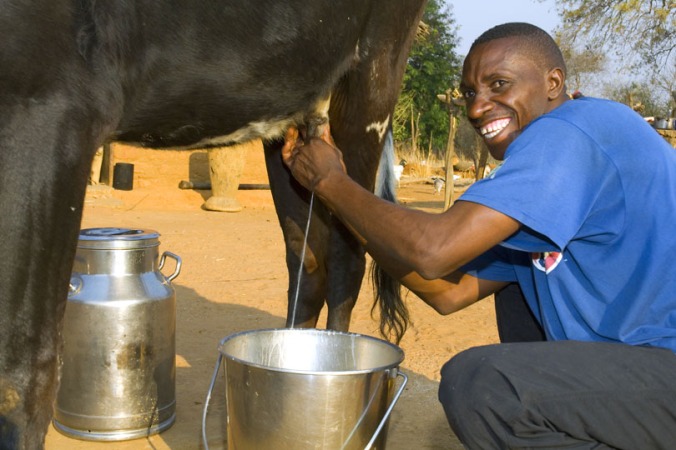 |
| Joseph Kasaka at Kaumba Dairy Farmers Co-operative |
IT’S widely believed that Southern Province has a higher number of cattle than its human population, information that adds weight to myriad cattle jokes. How accurate is this?
To begin with, when one visits areas like Moomba Constituency in Monze East, a temptation to believe in the joke arises and this is because of the number of cattle in the area.
Moomba, situated on the southern side of Lusaka, about 200 kilometres from the capital city, and 100 kilometres from the provincial capital of Southern Province, Choma, has an amazing number of cattle, evidenced from the number of farmers that sale milk to milk collection centres like Kaumba Dairy Farmers Co-operative.
In Moomba, livestock matters are a great deal, playing an increasingly important role in food security and economic development in the area.
In fact, the livestock sub-sector in Moomba is growing faster despite the challenges of no enough rainfall to enable a perfect grazing for the animals.
And importantly, the bulk of the livestock production in the area is occurring on small family farms.
Such kind of livestock farming has offered unique features to support local livelihoods and economies, especially for women.
“We use animals such as chickens, goats, pigs and cattle as a primary source of household food or as income from the sale of animal by-products here in Moomba and other areas in the country. Our animals represent an important asset to many families throughout the continent and that is why we guard them jealously,” says Judy Nchimunya 37, of Kaumba area in Chief Chona’s area in Moomba.
Ms Nchimunya said most rural households get some income generated from livestock activities.
She said although poor households tend to own smaller livestock, specifically chickens and goats, while wealthier ones tend to own larger animals, especially cattle, all households use their animals for economic benefits.
“If one has more cattle, the better because cattle is used for hire as transport and for cultivation purposes. For others that have goats or chickens, they can sale and use that money for other activities,” she said.
While clearly important for family livestock farms in the aggregate, livestock is also economically important at individual household level.
In many rural settings, livestock production comprises the most important part of individual household incomes and livelihoods.
Moomba’s Chona ward councillor Pearson Cheembo says more than 80 percent of residents of Moomba keep livestock and this trend has contributed to the economic viability of the area.
Mr Cheembo says animals such as goats and poultry, which are often in the control of women, are used for lumpy expenditures such as utility bills.
He said Moomba, like many other rural constituencies, livestock keeping improves a family’s social capital, improving access to other community services and functions.
 |
| Milk production on a smallholder farm in Magoye, Zambia |
Away from livestock, people of the constituency depend on agriculture for their living.
In every rural area, agriculture and rural development are essential to eradicate extreme poverty and hunger.
Most of the rural habitants depend directly on agriculture to survive.
A resident of Nkaba area in Moomba, Joseph Kasaka says agricultural has made a difference in the lives of poor people, mainly of women.
He says agriculture has contributed to both economic growth and to poverty reduction and food security.
“Moomba people love farming because we have seen its benefits. Agriculture is what keeps us going, so there is no way we can abandon this activity [agriculture] because it has changed our lives. The challenge we have is unpredictable weather which has affected our yield,” Mr Kasaka said.
Mr Kasaka said the constituency has not been spared from the effects of climate change.
He said climate change has a far-reaching impact on agriculture and mainly hit the poor adding that there is an urgent need for measures to reduce the impact on crop yields.
Moomba has four wards namely Chona, Moomba, Mwanza West and Mwanza East.
As per tradition, Moomba receives its share of the Constituency Development Fund (CDF), but just like several other rural constituencies, the CDF is not enough because of the numerous challenges the people of the constituency face.
For the 2013 CDF allocation, a number of projects were approved and undertaken.
Among these projects was the construction of the Kaumba Milk Collection Centre and the drilling of a borehole at Kaumba Dairy Farmers Co-operative.
Another project in the agriculture sector is the construction of the grain storage shed at Ntambo Co-operative Society and the completion of the communal shed and office at Kayuni East Development committee in Mwanza East ward.
Construction of a dip tank at Nkaba in Mwanza West ward is another project under the 20143 CDF.
In the education sector, 12 projects in all the four wards were approved and are nearing completion. Among these projects is the construction of classroom blocks at Sikabenga, Lukamantano, Moomba, Mabuyu, Namateba, Kasaka, Muntemba, St Patricks and Nkaba Primary schools in the area.
In the health sector, the constituency scored the first when it received the health post out of the 11 allocated to Monze district from the 650 that Government intends to construct countrywide.
Other projects under CDF include construction of Hachaanga, Sikabenga, and Namateba health posts.
Moomba has two chiefs Mwanza and Chona respectively. Moomba has a population of 29,545 (2010 Central Statistical Office Statistics).
PUBLISHED IN THE ZAMBIA DAILY MAIL ON JANUARY 31, 2016
No comments:
Post a Comment